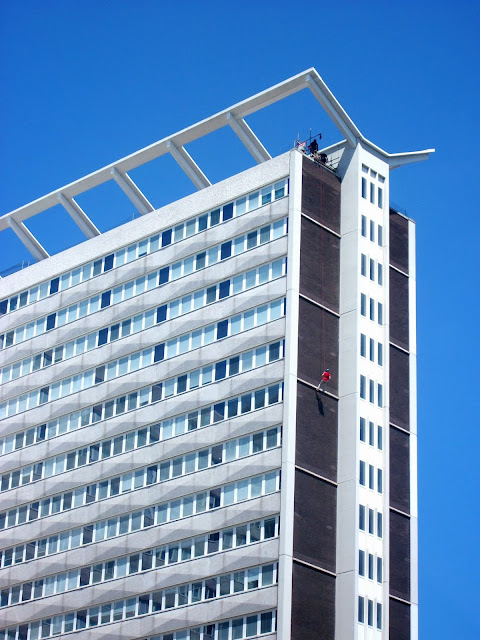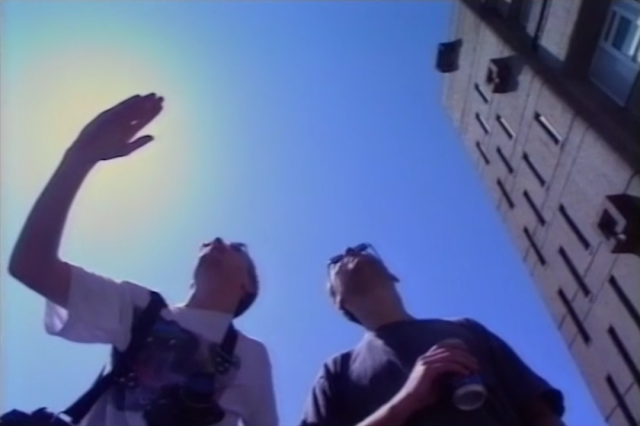Flight from Utopia
Flight from Utopia is a BBC2 documentary from 1984, written and presented by Patrick Nuttgens, one of Robert Matthew's prodigies. He followed his teacher by starting out as one of the cheerleaders of modern architecture and by the 70s had become more interested in heritage and preservation. This 2 part documentary is a kind of rise and fall of the postwar planners, focussing on a few Northern towns: Hull, Sheffield, York, Bradford and Leeds.



The last five minutes of part 1 focusses on the building of Park Hill, part of which in a renovated form lost out in the Stirling Prize yesterday, and includes Sheffield masterplanner Lewis Womersley's now famous interview where he described the opportunities that met him in the early fifties when he arrived for his job interview. Keith Massey's camerawork is quite brilliant, especially in the Park Hill sequence, but it's quite amazing to see so many tower blocks and postwar buildings in the mid-eighties, before so many were demolished, re-made or remodeled.
[Sadly Part 2 has since been taken down from YouTube, and the remainder of this article refers to that episode However the excellent Single Aspect blog has made it available here.]
As a documentary, its tone of voice and sweep echoes that of Lionel Esher's 1981 book A Broken Wave: a combination of elegy, personal reminiscence and historical document. The second part is filled with 'gloom and disaster' telling the tale of damp, miserable Hunslett Grange in Leeds among many other mistakes. The show's motto is undoubtedly that the road to hell is paved with good intentions. And those roads would be the ring roads that made Leeds the motorway city of the seventies.



There's some sad clips of Ian Nairn pulling apart Bradford's sorry town centre, one of many cities, in Nuttgens' words, ripped apart by insurance companies to keep us safe in our retirement, companies such as Norwich Union. The documentary ends up as a Gavin Stamp-style reminisce of the demolition of great Victorian buildings in the sixties.
The documentary ends with clips of Ronan Point collapsing, and John Poulson going to court for corruption, followed by the 'years of repentance' - with demolition of some of the new tower blocks. Although the documentary is angry, partial and sad, it's an incredible thing, a scene-setter for decades of hating on postwar planning, only recently being appreciated again in the form of a newly listed Preston Bus Station here or a Sirling shortlisted Park Hill there.
[The YouTube link below doesn't have sound but once again Single Aspect has come to the rescue with part 1 here]



The last five minutes of part 1 focusses on the building of Park Hill, part of which in a renovated form lost out in the Stirling Prize yesterday, and includes Sheffield masterplanner Lewis Womersley's now famous interview where he described the opportunities that met him in the early fifties when he arrived for his job interview. Keith Massey's camerawork is quite brilliant, especially in the Park Hill sequence, but it's quite amazing to see so many tower blocks and postwar buildings in the mid-eighties, before so many were demolished, re-made or remodeled.
[Sadly Part 2 has since been taken down from YouTube, and the remainder of this article refers to that episode However the excellent Single Aspect blog has made it available here.]
As a documentary, its tone of voice and sweep echoes that of Lionel Esher's 1981 book A Broken Wave: a combination of elegy, personal reminiscence and historical document. The second part is filled with 'gloom and disaster' telling the tale of damp, miserable Hunslett Grange in Leeds among many other mistakes. The show's motto is undoubtedly that the road to hell is paved with good intentions. And those roads would be the ring roads that made Leeds the motorway city of the seventies.



There's some sad clips of Ian Nairn pulling apart Bradford's sorry town centre, one of many cities, in Nuttgens' words, ripped apart by insurance companies to keep us safe in our retirement, companies such as Norwich Union. The documentary ends up as a Gavin Stamp-style reminisce of the demolition of great Victorian buildings in the sixties.
The documentary ends with clips of Ronan Point collapsing, and John Poulson going to court for corruption, followed by the 'years of repentance' - with demolition of some of the new tower blocks. Although the documentary is angry, partial and sad, it's an incredible thing, a scene-setter for decades of hating on postwar planning, only recently being appreciated again in the form of a newly listed Preston Bus Station here or a Sirling shortlisted Park Hill there.
[The YouTube link below doesn't have sound but once again Single Aspect has come to the rescue with part 1 here]











Any idea where this can be viewed part one no longer has sound?
ReplyDeleteThey're both live on the Single Aspect blog at the moment.
ReplyDeleteThanks so much for this grabbed now :)
ReplyDelete